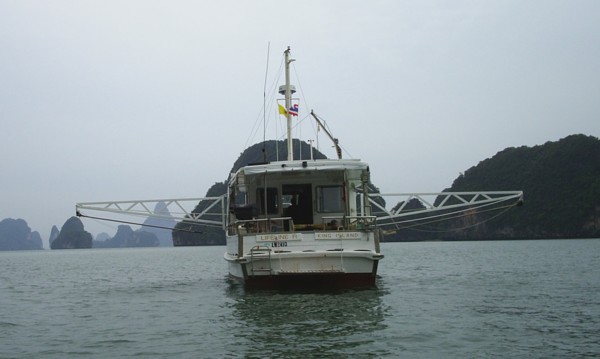
Lifeline Came with industrial strength flopper stoppers courtesy of her time as a cray fishing boat in Bass Strait. Her first set bent in a bit of serious weather so she got the ones that were "over-engineered to buggery".
Unlike the flopper stoppers featured in Captain Beebe's Voyaging Under Power which use "fish" on cables strung from arms which fold up, Lifeline's flopper stoppers are stainless steel plates on stainless pipes which attach to the arms with universal joints. The arms fold back slightly inboard of the handrails to make docking easier.
The biggest advantage of this system is that it is easy to store and deploy the stabilisers.

When we set out on a trip we always put the arms out so we are ready to drop the stabilisers whenever we need them. This is simply a matter of swinging each arm out and securing it with its fore and aft guy rope. The stabiliser itself sits in a niche on the arm. Philip walks along the side deck and just "plops" the stabiliser into the water. He pulls up the nylon retrieve rope and "Bob's your uncle"...
To pull in the stabilisers Philip slows to idle speed, lowers the retrieve rope (which is carried to the bottom of the stainless pipe by a weighted ring) and pulls the stabilisers up out of the water and into their niche. Our retrieve rope does not have a block or any form of gearing but it would be possible to set this up if the stabilisers were heavy.
Modifications
That's the basis of our stabilisers but we have modified them from the originals and Philip has played with them a bit to get even better performance.
The first modifications we made while the boat was still being converted were to improve amenity for a pleasure boat. We did two things:
We made the arms fold aft rather than forward for better visibility and docking;
We shortened each arm from 6 to 5 metres so they didn't intrude too much into our cockpit - our main living area.
We have watched lots of fishing boats going out the Gold Coast Seaway in rough conditions and talked to their owners and have concluded:
Solid stabilisers work better than fish;
They work best and lose least speed when they are kept vertical in each plane (foreward and aft and side to side);
They don't need to be deeper than the keel;
The best way to keep them vertical is to stay them forward and across the roof bracing
P.S.For those with a technical leaning, our good friend David in Sydney emailed us after reading the above, with the following explanation:
One note on the flopperstoppers- The erection of the arms
whilst travelling increases the rotational inertia(I). This slows the
frequency of roll which would result in a more comfortable ride. You should
be able to notice the difference in roll frequency(read period) with arms in
and out. It is like sitting on a rotating office chair or a ballet dancer
pirouetting. As arms are drawn in the rotational speed increases. The
technical explanation is called the principle of conservation of momentum.
I times omega is a constant where I is the moment of inertia and omega is
the rotational frequency(rpm in the vernacular). Therfore is I increases (by
putting arms out) omega has to decrease to obey the law of I times omega
being constant.
Thanks, David.